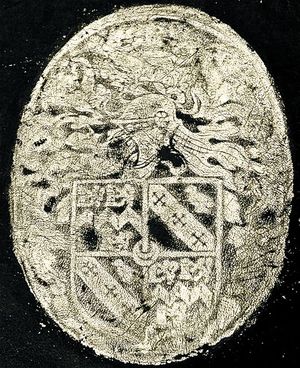Difference between revisions of "Thomas Smyth ca.1602-1668"
| Line 6: | Line 6: | ||
====Books==== | ====Books==== | ||
| − | An armorial binding stamp, recorded in three surviving examples, is attributed to Sir Thomas in the armorials database but the style of the bindings, contemporary with the late 16th and early 17th century imprint dates, suggests that the tool was used by an earlier member of the family, perhaps his father [[crossreference::Sir William Smyth|Sir William]] (ca.[[date of birth::1550]]-[[date of death::1626]]). One of these books has the 17th century inscription "Thomas Smith" (BL C.69.ff.12) as well as the 18th century bookplate of a descendent, [[family::Edward Smyth]]. Another belonged to [[crossreference::John Hacket]] (d.[[date of death::1670]]) and may have left Smyth ownership well before the time of Sir Thomas's death. The evidence suggests a family library at [[location::Hill Hall]] which passed through the generations although we do not know its size. Before Sir William, the Hall belonged to his uncle the Elizabethan diplomat and scholar [[family::Sir Thomas Smith]] ([[date of birth::1513]]-[[date of death::1577|77]]), who had a noteworthy library, much of which was [[bequest::bequeathed]] to [[education::Queens' College, Cambridge]]. Sir Thomas's will has no mention of books, but [[bequest::bequeathed]] all the residue of his personal estate to his [[beneficiary::son]] [[family::Edward Smyth|Edward]] who succeeded him as [[personal title::2nd baronet]]. Examples: | + | An armorial binding stamp, recorded in three surviving examples, is attributed to Sir Thomas in the armorials database but the style of the bindings, contemporary with the late 16th and early 17th century imprint dates, suggests that the tool was used by an earlier member of the family, perhaps his father [[crossreference::Sir William Smyth|Sir William]] (ca.[[date of birth::1550]]-[[date of death::1626]]). One of these books has the 17th century inscription "Thomas Smith" (BL C.69.ff.12) as well as the 18th century bookplate of a descendent, [[family::Edward Smyth]]. Another belonged to [[crossreference::John Hacket]] (d.[[date of death::1670]]) and may have left Smyth ownership well before the time of Sir Thomas's death. The evidence suggests a family library at [[location::Hill Hall]] which passed through the generations although we do not know its size. Before Sir William, the Hall belonged to his uncle the Elizabethan diplomat and scholar [[family::Sir Thomas Smith]] ([[date of birth::1513]]-[[date of death::1577|77]]), who had a noteworthy library, much of which was [[bequest::bequeathed]] to [[education::Queens' College, Cambridge]]. Sir Thomas's will has no mention of books, but [[bequest::bequeathed]] all the residue of his personal estate to his [[beneficiary::son]] [[family::Edward Smyth|Edward]] who succeeded him as [[personal title::2nd baronet]]. Examples: British Library C.69.ff.12, Cambridge UL Qq*.2.179. |
====Sources==== | ====Sources==== | ||
| Line 17: | Line 17: | ||
[[Category:Armorial Stamps]] | [[Category:Armorial Stamps]] | ||
[[Category:Bookplates and Labels]] | [[Category:Bookplates and Labels]] | ||
| − | [[Category: | + | [[Category:All Owners]] |
Revision as of 01:45, 27 July 2020
Sir Thomas SMYTH, 1st bart ca.1602-1668
Biographical Note
Second son of Sir William Smyth of Hill Hall, Essex. Admitted at Gray's Inn 1620. Inherited the Hill Hall estate from his nephew Edward in 1652; he also owned other estates in Essex. Created a baronet 1661; high sheriff of Essex 1663.
Books
An armorial binding stamp, recorded in three surviving examples, is attributed to Sir Thomas in the armorials database but the style of the bindings, contemporary with the late 16th and early 17th century imprint dates, suggests that the tool was used by an earlier member of the family, perhaps his father Sir William (ca.1550-1626). One of these books has the 17th century inscription "Thomas Smith" (BL C.69.ff.12) as well as the 18th century bookplate of a descendent, Edward Smyth. Another belonged to John Hacket (d.1670) and may have left Smyth ownership well before the time of Sir Thomas's death. The evidence suggests a family library at Hill Hall which passed through the generations although we do not know its size. Before Sir William, the Hall belonged to his uncle the Elizabethan diplomat and scholar Sir Thomas Smith (1513-77), who had a noteworthy library, much of which was bequeathed to Queens' College, Cambridge. Sir Thomas's will has no mention of books, but bequeathed all the residue of his personal estate to his son Edward who succeeded him as 2nd baronet. Examples: British Library C.69.ff.12, Cambridge UL Qq*.2.179.
